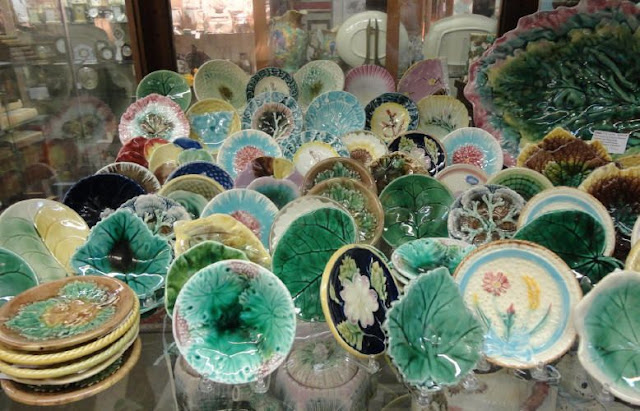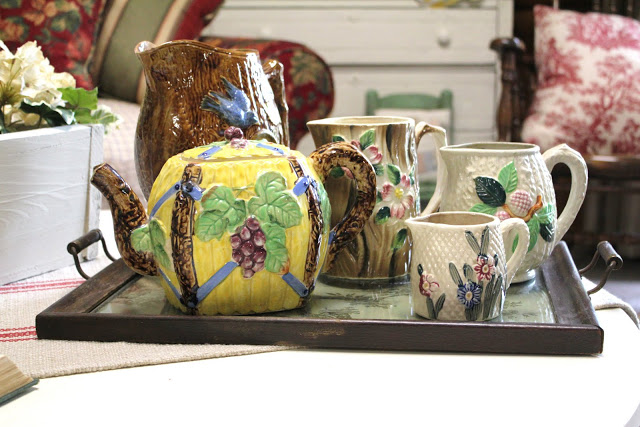The small Provincial town of Anduze, for which our planter gets it's name, is located in Cevennes region of the southern part of France. Potters worked in the area in the 15th century, but it wasn't until the close of the 16th century that the first Anduze planter appeared. According to legend a Cévenol potter, while visiting the Beaucaire fair just south of Avignon, was inspired by the elegant sample of Italian Medici style pottery that a vendor exhibited. This inspiration led the Frenchman to create his own take on the style and his Anduze planter stepped into the realm of the iconic.
The Anduze planter is stout and circular with a thick rim, embellished with garlands and stamped family crests representing the potter. During the reign of Louis X1V these pots became even more popular at the Palace of Versailles where nobility enjoyed their beauty as they filled them with flowering and fruit trees. Today Anduze planters are seen throughout France and their popularity extends around the globe.
If you desire for your landscape to be reminiscent of the French countryside be prepared to pay handsomely for these Anduze planters. However, there are some reasonable reproductions out there. Maybe you just like looking at them.....in that case enjoy the eye candy!
I simply adore Anduze pots! These classic French containers are icons of Mediterranean French gardens.
Thought of worldwide as French gardens "ornaments", Anduze planters are steeped in history.
Dominique Lafourcade
Well known since the 17th century throughout Provence, the French have been decorating their homes and chateaus with Anduze pots since they were first made in the charming little town of Anduze.
It is hard to imagine the maisons of Provence without the presence of Anduze pots.
pinterest.fr
Unlike the popular jarres de Biot which were used to store flour and preserve and transport olives, Anduze planters were used as decorative enjoyment only and served no real purpose but as eye candy.
During the seventeenth and eighteenth centuries, Anduze pots were only found on wealthy estates. The "vases d’Anduze" became en vogue when Marie-Antoinette decorated the gardens and terraces of Versailles with hundreds of the glazed planters.
There is just something about the Anduze pot that gives them a royal and grand ambiance. I love them planted in boxwoods.
In this and the following image you can see how the rustic look of these Anduze pots adds just the right character to the front entrance of this beautiful French home belonging to American expatriates Shauna Varvel and her husband Eric.
These wonderful containers will certainly make a big statement in most settings
Anduze planters are suitable for classic and formal gardens alike. The urns are at their best when planted with larger plants or small trees but these planters are also perfect for topiary and flowers!
An Anduze planter is characterized by it's shape, size, and the decorative shields, garlands of flowers and horizontal stripes that embellish it.
The design of this glazed pottery has endured throughout time and is still being made by hand by potters the same way their ancestors did.
via pinterest.fr
The original colour called flammé made the Anduze planter famous around the world. The color was actually stripes of three colors....yellow to symbolize the sun, green stripes represent foliage and brown denotes the earth.
Today Anduze planters are available in several stunning colors to further enhance your garden.
Green has always been a popular selection.
Atelier de Campagne
to an Anduze planter crafted with a soft aqua glaze.
Yet another stunning color for your garden. This Anduze planter is crafted of ceramic with a yellow glaze. So many ways to add color and texture to your home or garden.
The most authentic color of Anduze planter will reveal the pink of the terracotta when it rains but then will whiten up as they dry.
It doesn't matter what you choose to plant in your Anduze, it will simply look stunning. Here hydrangeas are the stars......
The Anduze planter is an amazing blend of simplicity and elegance.
You will never regret choosing to decorate your garden with these planters as they are timeless decorative elements.
via Pinterest
Whether well-aged with flaking glaze, a few small chips to the rim, or even some slight damages throughout the rest of the piece, nothing detracts from the charm and beauty of Anduze planters.
Anduze planters are still being made and are for sale at local shops in France, as well as from fine importers all over the world.
via Pinterest
Whether in groupings or standing alone, inside or out, the Anduze planter will give your gardens and homes an instant historical ambience.
Anduze containers are not frost proof so they do need to be brought inside at first sign of frost. They are so lovely inside the home you may never take them out again.
Click below to see the previous post
This blog post was published by Lisa Farmer
In the event that I have not credited the correct source of an image, please contact me at lisafarmerdesigns46@yahoo.com and I would be glad to correct it.
























































































